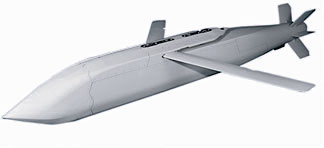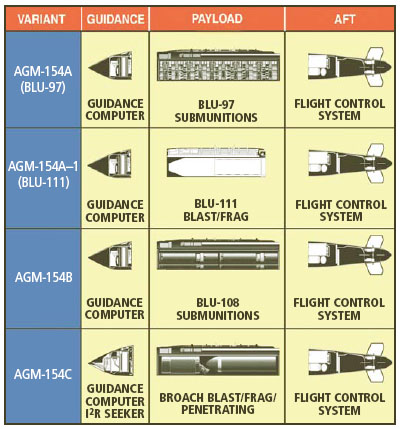The AGM-154 JSOW (Joint Standoff Weapon) is a modular precision-attack glide bomb, which is included in this missile directory because of its guided missile designation manufactured by Raytheon. The AGM-154 is the product of a joint venture between the United States Navy and Air Force to deploy a standardized medium range precision guided weapon, especially for engagement of defended targets from outside the range of standard anti-aircraft defenses, thereby increasing aircraft survivability and minimizing friendly losses.
It is also operated by armed forces in Australia, Finland, Greece, Poland, Singapore and Turkey.
The JSOW family of air-to-surface glide weapons are 450 kilograms (1,000 lb) class weapons that provide standoff capabilities from 28 km (15 nmi) low altitude launch and up to 110 km (60 nmi) high altitude launch. The JSOW can be used against a variety of land targets and operates from ranges outside enemy point defenses. The JSOW can be used against a variety of land targets and operates from ranges outside enemy point defenses.
Over 400 JSOWs have been used in combat operations, of which more than 300 missiles were launched during Operation Iraqi Freedom. The AGM-154 was also deployed in Operation Desert Fox, Operation Southern Watch, NATO's Operation Allied Force, and Operation Enduring Freedom.
Development
In 1986, the U.S. Navy started the AIWS (Advanced Interdiction Weapon System) program to develop a new precision guided short-range standoff attack weapon to replace laser guided weapons like the Paveway series guided bombs, the AGM-123 Skipper II and the AGM-65E Maverick. The primary development goal was a pure fire-and-forget weapon without any post-launch target designation, like a laser designator or a command data link. The AIWS competition was won by Texas Instruments (now Raytheon), who received a contract for the AGM-154A weapon in June 1992. In the same year, the AIWS program was combined with Air Force standoff weapons programs and renamed JSOW (Joint Standoff Weapon). The JSOW requirements called for a low-cost, light-weight weapon with at least 9 km (5 nm) range for low-altitude launches. A lock-on after launch (LOAL) capability was also desired, so that the launching aircraft would not have to put itself into line-of-sight from the target. Another requirement was "quiet launch" capability, i.e. the propulsion system (in any) was to be activated only some time after the release. Because the JSOW was to be used against different kinds of targets, a modular warhead section for cluster and unitary warheads was also required. As a solution to these requirements, Texas Instruments designed a GPS/INS guided unpowered glide bomb. The first guided drop of an AGM-154A occurred In December 1994, and in February 1997 operational evaluation by the U.S. Navy began. Initial Operational Capability (IOC) was reached in 1999, when full-scale production of the AGM-154A began.
Design features
The JSOW incorporates a low-signature/stealth design. The modular weapon body allows the integration of new sensors, warheads and sub-munitions. The stealth features enhance the survivability of the missile to strike actively defended targets. The payload bay can house lethal and non-lethal loads.
The missile can be launched at both day and night, and also adverse weather conditions. Its long standoff range ensures launch from outside the lethal envelope of most hostile air defence systems. The missile can reach up to a kinematic range of 130km when launched from an altitude of 40,000ft.
The JSOW has a length of 4.1m, wingspan of 2.69m and a diameter of 33.02cm (box-shaped, on a side). The weight of the missile is about 475kg.
Guidance and navigation
The JSOW is guided towards its targets by a highly-integrated global positioning system (GPS) or inertial navigation system (INS). The AGM-154C variant is additionally equipped with a terminal imaging infrared seeker for terminal guidance.
The missile can be launched from both high and low altitudes. It accurately navigates towards the target through selected waypoints. It receives the targeting information in preplanned mode from the cockpit of the launched aircraft. Onboard sensors or other third-party targeting assets provide information after the launch.
The JSOW C-1 variant is equipped with a two-way strike common weapon datalink (SCWDL) for striking moving marine targets.
Propulsion
The JSOW-ER ("ER" is for "extended range"), a powered version of the JSOW, is powered by a Hamilton-Sundstrand TJ-150 engine. The engine can be easily integrated on the back section of the JSOW, and provides an extended range from 130 to 560 kilometres (70 to 300 nmi). The free-flight demonstration of the missile was successfully completed in November 2009.
Aircraft compatibility
The JSOW can be launched from air force, navy or marine aircraft. The missile is integrated on the F-15E Strike Eagle, F-16 Fighting Falcon, F/A-18, AV-8B Harrier, B-2 Spirit and B-52 bombers, and A-10 aircraft.
The JSOW is also being integrated with the base F-35A Lightning II joint strike fighter and the carrier-based F-35C aircraft. The missile can be carried in the internal carriage bay of the F-35 aircraft. The aircraft-compatible design of the missile reduces integration costs for future aircraft.
The JSOW family includes a range of weapon variants. The AGM-154A is a baseline variant equipped with 145 BLU-97/B Combined Effects Bomb (CEB) sub-munitions. The missile variant is capable of engaging stationed aircraft, trucks, armoured vehicles and surface-to-air missile platforms.
The AGM-154A-1 is an improved version of the AGM-154A, which additionally carries a BLU-111 warhead to enhance blast-fragmentation effects without the unexploded ordnance (UXO) concerns with the BLU-97/B payload.
The AGM-154B is equipped with six BLU-108B/B canisters from the Air Force's Sensor Fuzed Weapon (SFW) program, which can launch four anti-armour sub-munitions against mobile area targets (total of 24 per weapon) that use infrared sensors to detect targets. When a submunition detects that it is aligned with a target, it fires, creating an explosively formed penetrator capable of defeating vehicle armor. This program concluded development but the Navy decided not to procure the weapon when the Air Force started to.
The AGM-154C version employs a 500lb Broach multi-stage warhead against fixed-point targets. The AGM-154C uses an Imaging Infrared (IIR) terminal seeker with autonomous guidance. The missile variant was authorised for full-rate production in December 2004 and accomplished initial operational capability in February 2005.
The JSOW C-1 is a modified variant of JSOW C, which adds a Link-16 weapon data link and moving maritime target capability to the AGM-154C. It was scheduled to be produced in 2009. The first three launches were conducted in August 2011 from an F/A-18F. Initial operational capability is scheduled for 2013.
Combat history
The AGM-154A was the first variant to be used in combat. The AGM-154A traditionally is used for SEAD missions. Initial deployment testing occurred aboard USS Nimitz and later aboard the USS Dwight D. Eisenhower. The first combat deployment of the JSOW occurred over southern Iraq on December 17, 1998 when launched by a single F/A-18C from the "Checkerboards" of Marine Fighter Attack Squadron 312, Carrier Air Wing 3 embarked aboard USS Enterprise during Operation Desert Fox. The glide range of the JSOW allowed the weapon to strike a target located in the southern suburbs of Baghdad. This weapon enjoyed success since its early use. One adverse event occurred in February 2001, when a strike of F/A-18s from the USS Harry S. Truman battle group launched a massive attack on Iraqi air-defense sites, nearly every weapon missed the target. The cause of the miss was reported as a software problem. This problem was solved soon afterward. Since 1998, at least 400 of the JSOW weapons have been used in the following conflicts: Operation Desert Fox, Operation Southern Watch, NATO Operation Allied Force, Operation Enduring Freedom, and Operation Iraqi Freedom.
General characteristics
Primary Function: Air-to-surface Standoff from Point Defense (SOPD) weapon, for use against a variety of targets.
Contractor: Raytheon Co.
Guidance: GPS/INS (Global Position/Inertial), Terminal infrared homing Seeker (unique to 'C' model)
Length: 410 centimetres (160 in)
Diameter: box shaped 33 centimetres (13 in) on a side / other source 40.6 x 51.9 cm
Weight: From 483 to 497 kilograms (1,065 to 1,095 lb)
Wingspan: 270 centimetres (106 in)
Aircraft Compatibility:
Navy: F/A-18C/D, F/A-18E/F
Air Force: F-16 Block 40/50, B-1B, B-2A, B-52H, F-15E, F-35A
Other: Jas Gripen
Range:
Low altitude launch - 12 nmi (22 km)
High altitude launch - 70 nmi (130 km)
Warhead(s):
BLU-97/B - Combined Effects Bomblets (JSOW A)
BLU-111/B - Unitary warhead (JSOW-A1)
BLU-108 - Sensor fused weapon (JSOW B - now cancelled)
BROACH multi-stage warhead (JSOW C)
Unit Cost:
AUPP AGM-154A, $282,000. Total program cost: $3,327,000.
AGM-154B, $484,167. Total program cost: $2,033,500.
AGM-154C, $719,012. Total program cost: $5,608,000.

